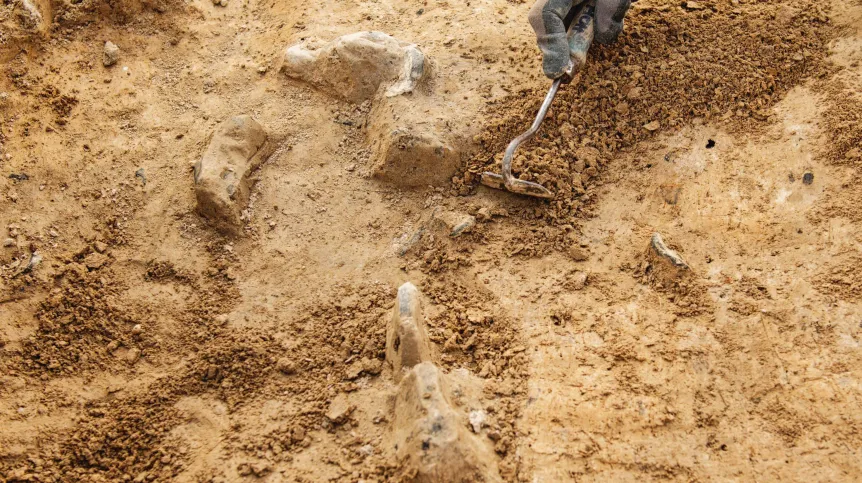
Recent excavations confirm that between the 10th and 13th centuries, a settlement complex developed intensively in Czermno, which was the main centre of the so-called Cherven Cities, says research leader Dr. Tomasz Dzieńkowski from the Institute of Archaeology of the Maria Curie-Skłodowska University in Lublin.
Further research was carried out in August in the early medieval settlement complex in Czermno (Lublin province).
'Research carried out over the last few years confirms that we are dealing with the historical Cherven. In the Bug River zone, there was no other such dynamically developing settlement complex with a huge number of monuments that would confirm its elite, defensive and commercial character,’ says Dr. Dzieńkowski
'The settlement complex developed intensively between the 10th and 13th centuries. We are particularly interested in the beginnings of the stronghold settlement, the development of the entire complex, the functions it performed, as well as the events or processes that caused the settlement to disappear,’ he adds.
The term 'Cherven Cities' first appeared in the Kievan Rus' Primary Chronicle. Research and discussions on the identification of Cherven and Cherven Cities have been going on for 200 years.
The castle complex in Czermno is one of the most recognizable and at the same time intriguing in terms of research in Central and Eastern Europe. This is due to the fact that there was a dispute over these areas between the Piasts and the Rurik dynasties. Research discussion about the cultural and political significance of the centre is the key to understanding the processes that took place on the border.
'It must also be admitted that we do have something to study. The settlement complex was distinguished by its size and orderly structure. It consisted of a stronghold and settlement base formed by numerous settlements,’ says Dr. Dzieńkowski. ‘The area of the stronghold and settlement complex was estimated at approximately 150 ha. 'This indicates a large scale of settlements.’ he adds.
The archaeologist explains that the August excavations covered a five-hectare area considered to be the outskirts, surrounded by a rampart from the north, as confirmed by previous research.
'It was a well-organized settlement with residential, craft and utility buildings, where everyday items were produced. In one excavation, we captured a fragment of a wooden track, an internal street,’ he says. He adds that determining the time of construction of wooden structures will make it possible to determine the moment of settlement and development of the area.
'In and area of 60 square meters, we found thousands of fragments of pottery and a group of separate artefacts. In total, over 40,000 items,’ he says, adding that if the research covered a larger area, there would be more finds, but this would require appropriate preparation of research facilities and financing.
Speaking in detail about the artifacts, Dr. Dzieńkowski mentions jewellery typical of the Ruthenian-Byzantine zone (glass rings, bracelets), curiosities such as a fragment of a glazed Easter egg, and a side panel made of deer antlers and decorated with a geometric ornament (a fragment of a horse harness). Researchers also found spindle whorls, knives, products made of iron and a significant number of Drohiczyn type seals.
Dzieńkowski explains that the seals were used in trade to mark goods. They were made of pieces of lead with the owner's marks imprinted. 'We believe that the outskirts were a place where goods for trade were stored or transhipped. This indicates that, in addition to its military function, the stronghold also had a commercial role,’ he says.
'Czermno is located on the Huczwa River that flows into the Bug, which was used as a river route in the Middle Ages, similar to today's +highway+. Goods could be transported on a river faster than on land roads. This indicates that the stronghold could have had a significant role as a trade centre,’ Dr. Dzieńkowski continues.
In addition to the excavations carried out as part of the Maria Curie-Skłodowska University student internships, GPR research was also carried out under the supervision of scientists from the Institute of Archaeology and Ethnology of the Polish Academy of Sciences.
'The results are very clear. There are rows of cottages, residential and most likely utility buildings, streets and a large building, the purpose of which is difficult to determine without excavation research,’ Dr. Dzieńkowski says.
After the end of the excavation season, the artefacts will be subjected to detailed analysis, conservation and documentation. Dzieńkowski also attaches great importance to the results of dendrochronological and radiocarbon research. He emphasises the need for further research in the outskirts of the stronghold and says that archaeologists will return to Czermno.
'Excavations in Czermno are part of a larger research campaign that has been carried out on the Polish-Russian border since the 1950s, and particularly intensively over the last ten years,’ he says.
He adds that the involved institutions - in addition to the Maria Curie-Skłodowska University and the Institute of Archaeology and Ethnology PAS - include the University of Rzeszów and the Leibniz Institute for the History and Culture of Eastern Europe in Leipzig, Germany.
Survey excavations in Czermno are carried out as part of a scientific project co-financed by the Polish Ministry of Culture and National Heritage. (PAP)
Author: Piotr Nowak
pin/ dki/ kap/
tr. RL













